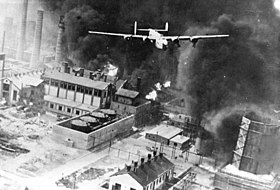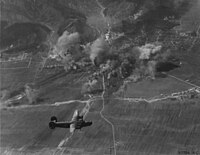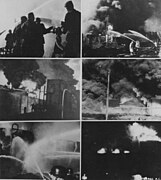Western Allied Campaign in Romania
| Western Allied Campaign in Romania | |||||||
|---|---|---|---|---|---|---|---|
| Part of Oil Campaign and Eastern Front of World War II | |||||||
 A B-24 Liberator called "Sandman" during a bomb run over the Ploiești Astra Romana refinery during Operation Tidal Wave | |||||||
| |||||||
| Belligerents | |||||||
|
|
Support: | ||||||
| Commanders and leaders | |||||||
|
Arthur Tedder |
| ||||||
| Casualties and losses | |||||||
|
325 aircraft destroyed (259 by Romanian forces) 32 tanks leased to the Red Army captured 1,706 killed 1,123 captured | 80+ Romanian aircraft | ||||||
| 7,693 civilians killed | |||||||
The Western Allied Campaign in Romania consisted of war declarations and aerial operations during the
War declarations
Romania declared war on the British Empire on 6 December 1941 and on the United States on 12 December. The British returned the war declaration that December, however, the Americans only did so in the summer of 1942. Two American allies, Nicaragua and Haiti, declared war on Romania on 19 and 24 December respectively. Romania promptly returned these declarations. Four British allies also declared war on Romania: Canada (7 December), New Zealand (7 December), Australia (8 December), and South Africa (9 December). However, Romania never returned these declarations (likely because the four countries were seen as British subjects by the Romanian leadership).[2]
Early plans
The first plans focused on disabling the
Aerial operations
United States Army Air Forces

When the
In early 1943, at the Casablanca Conference, Churchill once again reiterated the importance of attacking Romania's oil refineries and disrupting the German war effort. Due to a lack of resources, planning was postponed until April 1943, when General Henry H. Arnold commissioned his staff to resume their development.[5]
After Tidal Wave, further bombing operations were focused in the

With the
At the start of June 1944,

Royal Air Force
Starting in April 1944, seven
The RAF also conducted bombing raids on
Aftermath

In 1944, US bombers flew on more than 42
In just over a year, from Operation Tidal Wave until the 1944 bombing campaign was called off, the Romanian aircraft, aided by Romanian artillery, shot down 259 Allied aircraft (223 bombers and 36 fighters). Allied Nazi German forces shot down 66 more Allied aircraft. In total, Allied casualties amounted to 1,706
Western Allied prisoners
The
All Allied airmen who were taken prisoner during the air campaign were repatriated by
Ground operations
Although not directly engaging Romanian ground troops, the Western Allies had supplied military equipment to the Red Army via Lend-Lease. The Romanians had captured some Western tanks that had been leased to the Soviets: four M3 Lees, twenty-one M3 Stuarts, four Valentine Mk IIIs and nineteen unspecified Vickers tanks.[30][31]
Gallery
-
AB-17 bomberbursts into flames after being hit by flak over Ploiești
-
B-17s over Ploiești on 28 July 1944
-
Bombing of Brașov on 16 April 1944
-
Firefighters extinguishing flames in Ploiești
See also
References
- Crowood Press. p. 95.
- ^ Erik Goldstein (2005). Wars and Peace Treaties: 1816 to 1991. Routledge. pp. 216–218.
- ^ Alexandru Popescu. "Rețeaua Rică Georgescu". Historia (in Romanian). Retrieved 30 March 2024.
- ^ Zaloga 2019, p. 5.
- ^ a b c d McGowan, Sam (2015-08-07). "Operation Tidal Wave Takes Aim at Ploesti". warfarehistorynetwork.com.
- ^ Martin Folly; Niall Palmer (2010). The A to Z of U.S. Diplomacy from World War I through World War II. Scarecrow Press. p. 86.
- ^ Eric Hammel (2010). Air War Europa: Chronology: America's Air War Against Germany In Europe and North Africa, 1942 - 1945. Pacifica Military History. p. 48.
- ^ "Operațiunea HALPRO - primul bombardament USAAF asupra României - 12 iunie 1942". iar80flyagain.org (in Romanian). 2022-11-25.
- ^ "Raport Subsecretariat de Stat al Aerului". iar80flyagain.org (in Romanian). 2023-05-17.
- ^ a b Zaloga 2019, p. 82.
- ^ a b Zaloga 2019, pp. 84–85.
- ^ "Efectele bombardamentelor asupra rafinăriilor". iar80flyagain.org (in Romanian). 2023-05-17.
- ^ Zaloga 2019, pp. 85–87.
- ^ Horia Stoica (22 September 2022). "IAR III-Producția în timpul războiului, bombardarea și dispersarea fabricii-1941-1945". independentaromana.ro (in Romanian).
- ^ Zaloga 2019, p. 87.
- ^ a b Zaloga 2019, pp. 88–90.
- ^ Axworthy 1995, p. 313.
- ^ a b c Frank Joseph (2011). The Axis Air Forces: Flying in Support of the German Luftwaffe. ABC-CLIO. pp. 171–175.
- ^ a b David Gunby (10 February 2017). "Mining the Danube in 1944". RAFCommands Forum.
- ^ Bill Taylor. "A Tight Squeeze". Scottish Saltire Aircrew Association.
- ^ a b Lucian Dobrovicescu. "Aprilie 1944. Moartea vine din cer: Bombardamentele Aliate asupra României". Historia (in Romanian).
- ^ "Bombardamentele din aprilie 1944 ale aviației anglo-americane asupra Bucureștilor și Ploieștilor". Agerpres (in Romanian). 4 April 2019.
- ^ a b "No. 40 Squadron Wellington X ME990 -R F/O. Lawrence Franklin Tichborne". aircrewremembered.com. October 2018.
- ^ "No. 614 Squadron Halifax II JP225 F/O. Bruce Willard Prange DFC". aircrewremembered.com. October 2018.
- ^ a b Bernád 2003, p. 53.
- ISBN 973-96405-8-3.
- ^ Axworthy 1995, p. 314.
- ^ "Operatiunea Reunion (I)". iar80flyagain.org (in Romanian). 2022-10-28.
- ^ Daniel Haulman (30 May 2012). "Operation Reunion and the Tuskegee Airmen" (PDF). Air Force Historical Research Agency.
- ^ Axworthy 1995, p. 221.
- ^ Greg Kelley; Jason Long. "Romanian Armour in World War Two". Archived from the original on 26 September 2003.
Bibliography
- Axworthy, Mark (1995). Third Axis, Fourth Ally: Romanian Armed Forces in the European War, 1941–1945. London: Arms and Armour.
- Bernád, Dénes (20 June 2003). Rumanian Aces of World War 2. ISBN 978-1-84176-535-8.
- ISBN 9781472831965.




